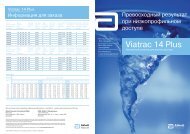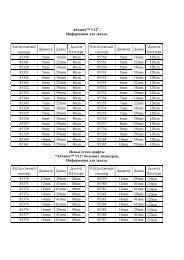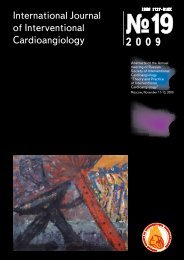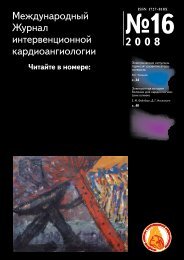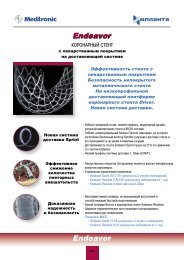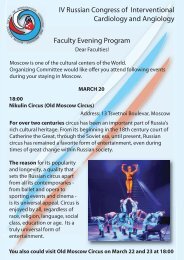International Journal of Interventional Cardioangiology
International Journal of Interventional Cardioangiology
International Journal of Interventional Cardioangiology
Create successful ePaper yourself
Turn your PDF publications into a flip-book with our unique Google optimized e-Paper software.
INTERVENTIONAL CARDIOLOGY<br />
<br />
<br />
<br />
<br />
<br />
<br />
<br />
<br />
<br />
<br />
<br />
<br />
<br />
<br />
Figure 4. Absence <strong>of</strong> ST changes over time during ineffective<br />
thrombolytic therapy. Patient C., 60 years old. Diagram <strong>of</strong><br />
ST segment shift during thrombolytic therapy. The dashed<br />
line indicates the isoelectric line in leads V 1<br />
, V 2<br />
, V 3<br />
.<br />
Thus, there is an opinion that ST decline by 50%<br />
is sufficient in anterior infarctions, and decrease<br />
by 70% is optimal in inferior infarctions (5). G.<br />
Schroder suggested grading <strong>of</strong> ST resolution degree<br />
as total (≥70%), partial (30% to 70%) and absence<br />
<strong>of</strong> decrease (ST changes over time less than by 30%)<br />
(7). It is well known that degree <strong>of</strong> ST decrease during<br />
reperfusion therapy is closely related to patients<br />
prognosis (6, 10).<br />
Another relevant issue is the time <strong>of</strong> ECG recording<br />
in order to assess the changes over time. In HIT-4<br />
study it was shown that in the group where streptokinase<br />
was administered as fibrinolytic, thrombolytic<br />
therapy efficacy criteria assessed in 90 minutes<br />
were achieved only in 25% <strong>of</strong> patents, whereas in<br />
the group <strong>of</strong> tissue plasminogen activators – in 35%<br />
<strong>of</strong> patients. Proportion <strong>of</strong> patients with successful<br />
thrombolysis assessed in 180 minutes was 50% in<br />
both groups (7). Thus, the time <strong>of</strong> ST decrease and<br />
the time interval for assessment <strong>of</strong> changes over<br />
time depends among others on the type <strong>of</strong> fibrinolytic<br />
drug used. Thrombolytic therapy efficacy assessment<br />
performed in 180 minutes provides more reliable<br />
results than that performed in 90 minutes and<br />
much less in 60 minutes.<br />
However, if thrombolytic therapy fails, repeated<br />
administration <strong>of</strong> thrombolytic drug is not very effective,<br />
and such patients demand transluminal balloon<br />
angioplasty (3, 11). Since the volume <strong>of</strong> salvaged<br />
myocardium depends closely on the time from angina<br />
attack onset to coronary blood flow restoration,<br />
decision about “saving” PCI performance should be<br />
taken in shorter time. In the current guidelines this<br />
<br />
Figure 5. Examples <strong>of</strong> ECG recordings in Patient C performed before initiation <strong>of</strong> thrombolytic therapy and in 90 and 180 min. The arrows indicate<br />
the ST shift degree in leads with maximal elevation, there are no changes over time.<br />
Types <strong>of</strong> ST Segment Resolution during Thrombolytic Therapy<br />
in Patients with Acute Coronary Syndrome<br />
19




